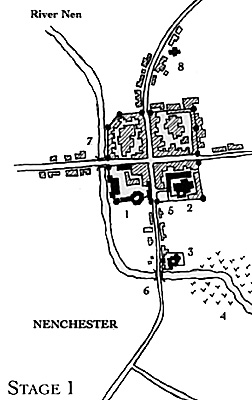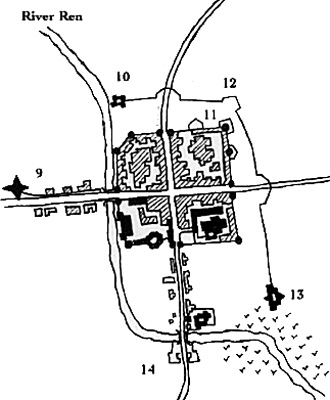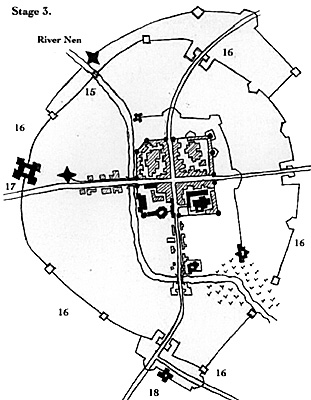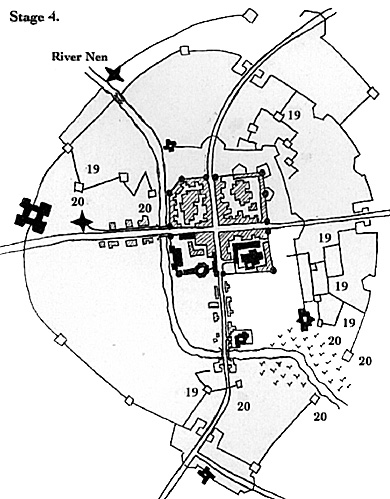It is 1643. The borders of the Eastern Association lands are the focus for raiding and skirmishing by both sides. Towns and manor-houses have been forced to look to their defences, and, up until now, stone walls and vigilance have proved enough to deflect small parties of raiders. However, the garrison of Nenchester have heard that a strong Royalist army with siege guns is on its way south from the Midlands. This constitutes a more serious threat, and preventative measures will have to be taken. These will include strengthening the defences, stocking up for a siege, and denying the enemy food and shelter. In the hypothetical account below, real examples are noted in parenthesis.
Stage 1
Nenchester is a settlement dating to pre-Domesday times. It has a castle, fallen into some disrepair these last two centuries or so: a central mediaeval area still bounded by the remains of the town walls but with suburbs outside them: a number of monastic houses- one, now the Cathedral, both inside the walls and without: the River Nen still limits growth on two sides. By the South Bridge is the Friary, and houses line South Street from here to the South Gate. West Street beyond the bridge also has a small suburb. From North Gate the road is lined with houses and a church, whilst there are encroachments on the walls themselves in the north-east sector. East Street has only a few houses beyond the walls.
Stage 2
An assault is likely to come from the north-east, or landward side, so the suburbs in this quadrant have been demolished to give the defenders clearer fields of fire, and to deny the attackers any shelter close to the defences. [Chichester] The tower of the church off North Street would provide the attackers with a useful vantage point overlooking the defences, so this, too, has been cleared. [Wallingford] The evicted inhabitants of these properties have been taken within the walls and, in some cases, provided with alternative plots. [Oxford] Much of the building materials from these demolitions has been utilised in the construction of the new defences, which will be built by civilian labour. [London] A bank and ditch has been dug around the north and east sides of the town with a sconce at each end to anchor the defences to the river and to the marsh. [Bristol]
Where the roads enter the defended area, demi-bastions straddle the entrances which are blocked by barricades of carts and chevaux de frise- horizontal tree-trunks with sharp branches protruding at all angles. [ Chester ] These barricades can be swung aside for sallies out, or to let reinforcements in. At the north-east angle is a full bastion.
At the South Bridge a hornwork has been built to retain control of the crossing. It has also been deemed advisable to ensure that the West Bridge is similarly safeguarded, so the houses are reprieved, and a sconce has been constructed by the road, linked by covered way to the bridge. [ Pontefract]
The walls themselves are strengthened with earth both inside and out. Some of the towers will carry small artillery pieces, [ Exeter ] and both castle and cathedral precinct [ Lichfield ] will be capable of providing bases for resistance to the bitter end should this prove unavoidable. The Friary by the South Bridge has had its outer walls loopholed for musketry, [Leicester] and strengthened on the inside with bales of wool, sacks of produce, and anything else which comes to hand and might absorb cannon shot. [ Bristol ] Finally, in the vulnerable north-east angle of the walis, small bastions have been added to the face of the wall. [ Worcester ] Each of the two bridges has had a span removed and a drawbridge inserted. [Huntingdon and St. Ives]
Stage 3
The attacking army has approached and invested Nenchester. A circumvallation of bank and ditch has been constructed around the whole town to prevent anyone entering or leaving. [Newark] Astride the northern road is a fortified camp to safeguard HQ, supplies of both food and powder, the baggage train, and troops being prepared for an assault. It is wholly likely that the defenders will receive help from the south, both in the form of cavalry raids on the besiegers, and, more substantial efforts to raise the siege with a relieving army. The besiegers, therefore, have designed their circum-vallation to take account of these factors. Some of the sconces and redoubts face onto the field as well as into the town. Those guarding the south and west approaches are particularly strong since these are the anticipated directions for relief forces to take.
As the defenders expected, it is the north-east corner which will be the focus for the most determined assaults. The besiegers have established batteries to bombard the defences in this sector prior to an assault; mortars have been deployed to fire into the town in order to encourage the civilians to press for an early capitulation; other strongpoints seal off the town in the south and west in order both to underline the unlikelihood of relief, and to ensure that the defenders continue to spread their troops around the entire perimeter. If defenders are redeployed to points under greater threat, then opportunist action can be taken by the besiegers.
Stage 4
The besiegers are now in a position to commence active operations. A number of trenches are pushed forward enabling artillery pieces to be brought closer to the defences with the intention of creating breaches through which assaults may be made. [Lyme Regis] That on the west is intended to render the defenders' bridgehead untenable but will also bring fire to bear on the rear of the northern outworks. It may also be possible to breach the inner walls here and effectively to cut off the north-western sconce. The approach to the southern bridge and the friary is a feint but, nevertheless, threatening.
The main thrust of the attack is in the north east and east aiming to neutralise the south-east sconce, to breach the outer defences to its north, to destroy the north-east outer bastion, and breach the inner walls either side of the corner tower. Mortars will fire into the town itself both to demoralise the civitians and to cause fires which will destroy food supplies and munitions. [Bridgwater]
Once the parallels have been dug close enough to the walls, then tunnels can be used to undermine them, [York] guns will keep hammering away at the breaches, various explosive devices will be employed to blow in gates, and, at the appropriate moment, troops, fortified by strong drink, [Oswestry] will be sent into the breach to storm the town and exercise their rights as victors. Re-discovered mediaeval siege machines such as belfries or sows may be used. [Gloucester] The defenders, meanwhile will have constructed further barricades across the gorges of the compromised bastions, [Clonmel] and will have assembled every man, woman and child to load muskets, boil water and oil for pouring over the storming party, [Corfe] wield long poles for dislodging ladders and tend the wounded.
There are a number of possible resolutions to Nenchester's predicament:
- a relief force may appear in the nick of time
- a sally by the garrison might drive away the besiegers
- the besiegers may withdraw to meet another threat to themselves
- the besiegers may get bored and go away
- the assault might carry the main defences
- treachery might let the besiegers in
- an assault may be effected by stealth or surprise
- the defenders may run out of food and shot and be forced to surrender
- the townsfolk might force the governor to surrender
- the governor might do a deal with the besiegers
On the basis of real Civil War sieges, each side has a 50:50 chance of success, but in the event of the besiegers winning, they are six times more likely to come to terms than to prevail by storm.
Maps
Key to Plans
- 1. Castle
2. Cathedral
3. Friary
4. Marsh
5. South Gate
6. South Bridge
7. West Bridge
8. Northern Suburbs
9. Western Sconce
10. NW sconce
11. NE Tower
12. NE bastion
13. SE sconce
14. S hornwork
15. pontoon bridge
16. circumvallation
17. West Fort
18. South Fort
19. Parallels
10. Bridge

Stage 2

Stage 3

Stage 4

Back to English Civil War Times No. 53 Table of Contents
Back to English Civil War Times List of Issues
Back to Master Magazine List
© Copyright 1997 by Partizan Press
This article appears in MagWeb (Magazine Web) on the Internet World Wide Web.
Other military history articles and gaming articles are available at http://www.magweb.com